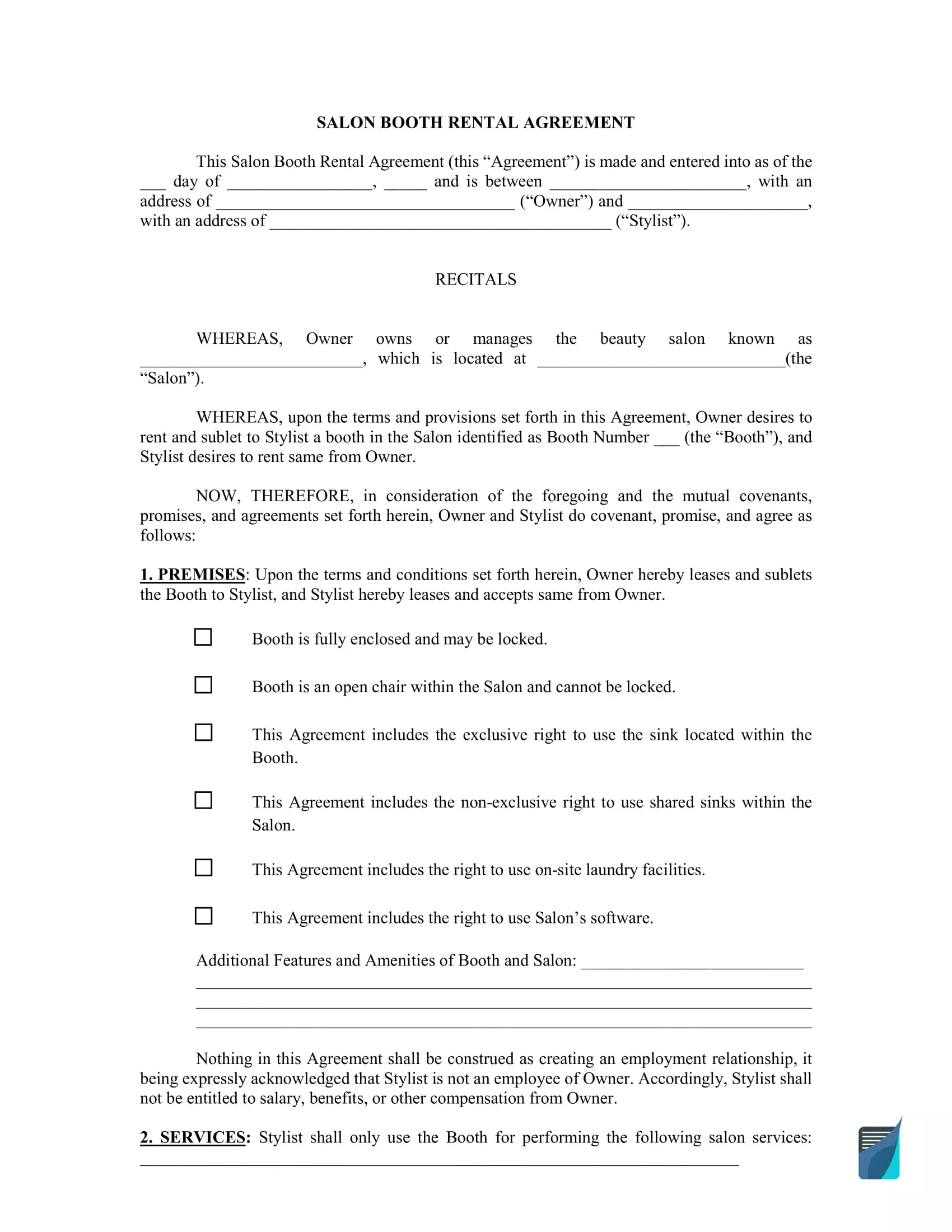
Renting out space in your salon or barbershop isn’t something you should do lightly, but it can be an easy way to get a secure income and make sure you aren’t leaving dollars on the table with an empty chair. Letting an experienced and qualified stylist rent your space can be a great way for new salons to attract more clients and can even help the other stylists in your salon.
Salon leasing is a win-win scenario if you have a good rental agreement and know what to look for in potential stylists.

Create a Personalized Salon Booth Rental Agreement Form online in under 5 minutes!
Build Your Document
Answer a few simple questions to make your document in minutes
Save progress and finish on any device, download and print anytime
Your valid, lawyer-approved document is ready
. or download your Salon Booth Rental Agreement Templates as a PDF file Create a Personalized Salon Booth Rental Agreement Form online in under 5 minutes! Table of ContentsBefore you can rent your booth to stylists, you need to know what to include in your rental and what you control when you’re working with them. There are a lot of details that can go into your booth commercial lease template, or you can choose to go with a slimmer less restrictive agreement.
There are some basic things that pretty much every stylist is going to need in a rental agreement, so don’t be surprised if you don’t get a lot of offers if you’re missing any of these things.
All three of these things can be customized to some extent, but you’ll need to include these items to have a functional booth rental contract. You’ll also need to decide whether you’re paying taxes for the whole salon or if the stylist will be responsible for real estate taxes on the rented booth. The last basic thing you’ll need to think about is product sales. If you’re already selling products as a salon, then you might not want a stylist using your space to also offer their own product lines.
Like any lease agreement, it’s important to have all the details about how the space can be used worked out before you sign. For instance, you don’t want a stylist renting a booth to offer cuts and color at prices that undercut your rates and the rates of your other stylists. You can require set prices, or allow the stylist to set their own, but you may want to include their rates in the contract and negotiate any changes. You can ask for stylists to collect their own payments or you can collect client payments yourself. If you collect payments for them, you’ll need to make sure you’re keeping track of their earnings and paying out the full amount. Some salons and barber shops will also offer receptionist services to independent stylists renting space in the salon. It’s up to you whether you want to include receptionist services or software, but it is one way to make your booth more attractive.
Renting out a booth is very different from hiring a stylist as an employee, and there are some serious pros and cons you should consider before you decide if booth rental is right for you.
One of the biggest advantages of booth renting as a salon owner is that booth renting guarantees that you’ll have a certain amount of income every month. However, chances are you won’t be making as much money from a successful stylist renting space as you would if they were an employee because most stylists won’t rent unless it offers a financial advantage over traditional employment. So, while you’re taking on less financial risk by renting, you’re also lowering your profit margins on a successful and talented stylist.
Renting a booth comes with the advantage of being able to keep more of your earnings. Most salon employees only make about 50% of what they charge per service, while you’ll be able to keep 100% of your earnings after paying rent. That can be a huge advantage, but it also comes with greater responsibility. You’ll need to work to build your business and maintain your station appropriately and will still be responsible for following salon rules and business hours like a regular employee.
Step 1: Prepare the Booth
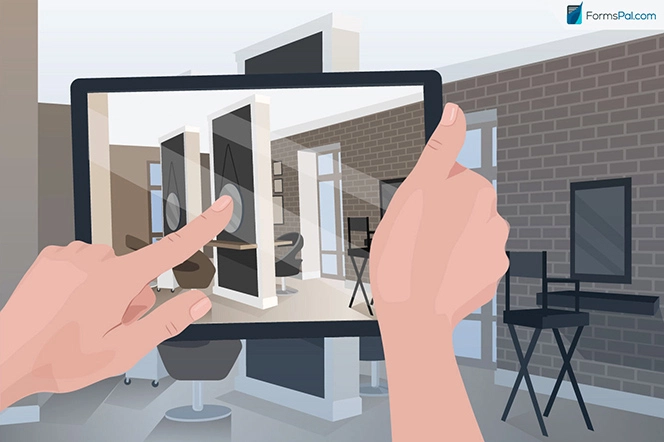
The first thing you need to do is make sure everything in the booth is in good working condition. You’ll need to thoroughly clean all of your equipment, check its effectiveness, and take pictures to show potential tenants.
Step 2: List the Booth
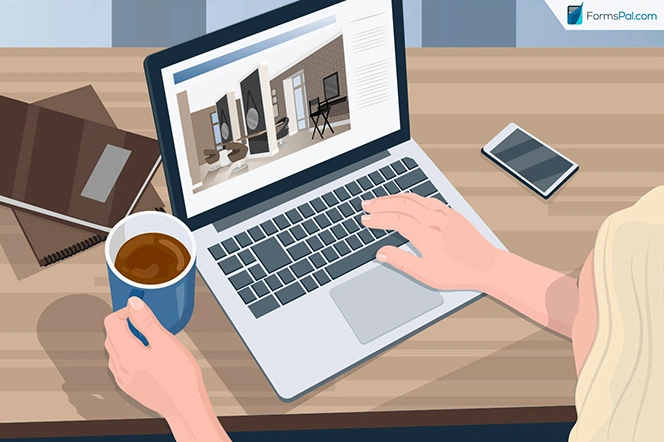
The next step is listing the booth on any local job boards, salon leasing and stylist websites, or social media sites in your area.
Step 3: Interview and Vet Potential Tenants

Once you have people applying for the rental space, it’s still important to make sure you’re checking a few more boxes. Potential tenants should fill out a standard job application so you can see their work history. A good work history is a great way to make sure the stylist can afford your space. You’ll also want to conduct a background check to make sure they don’t have any criminal convictions that could make it more difficult for them to build their client list. Lastly, you’ll want to make sure the stylist is licensed in your state. You can be held partially liable for an unlicensed stylist working in your salon, so you need to know not only that they are licensed, but that the license is current and valid in your state.
Step 4: Signing and Move-In
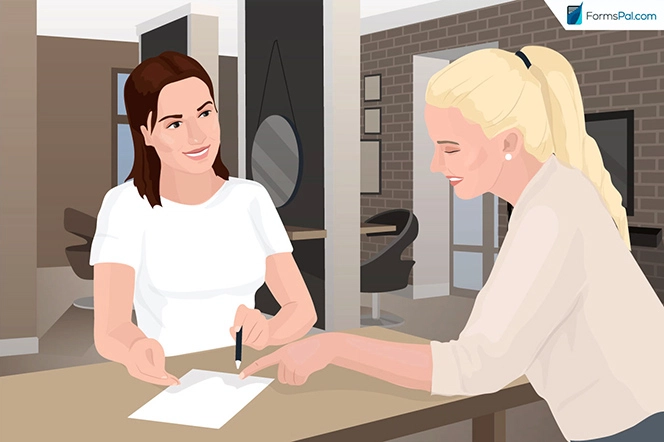
Once you have a tenant selected, it’s time to go over all the paperwork and sign the agreement. The stylist will likely want to negotiate parts of the agreement, so it’s a good idea to have some idea of what you’re willing to negotiate and what you won’t change for a good stylist. You’ll also want to clean the booth one more time before moving the stylist in, that way they’ll be able to get to work as soon as possible and start making back some of the money they’ve paid for the booth rental.
| Document Name | Salon Booth Rental Agreement Form |
| Other Names | Barber Booth Rental Agreement, Barber Shop Lease Agreement |
| Avg. Time to Fill Out | 14 minutes |
| # of Fillable Fields | 77 |
| Available Formats | Adobe PDF |
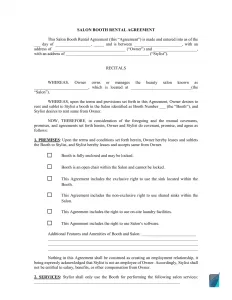
Step 1: Personal Information

Both the lessor and the lessee will need to fill in their personal information, including their full legal names, their current addresses, and the date of the agreement.
Step 2: Salon Premises and Service, and Retail Agreements
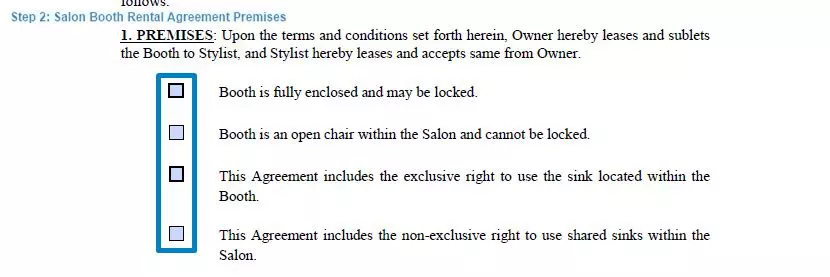
Next, the new landlord will need to define the space of the rental, including the address of the salon, any identifying information about the booth, the amount of space included, and any accessories, furniture, or additional tools included in the rental. Sink, laundry, and chair arrangements are all included in this section.
Step 3: Terms of Agreement and Rental Date
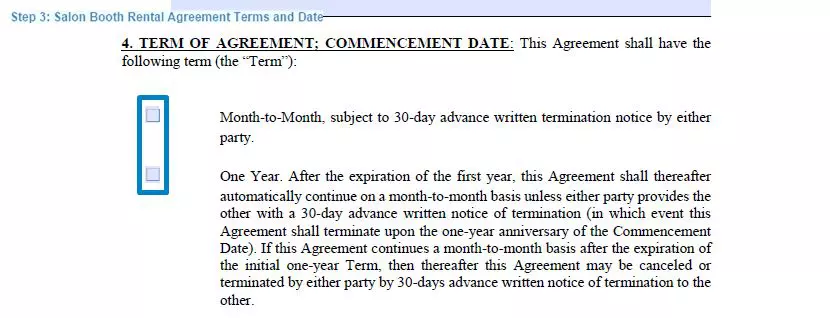
This section will cover whether the stylist will be able to access salon software and other services, whether the stylist will be able to set their own prices or needs to follow the pricing schedule set by the salon, and what kinds of services the stylist is allowed to offer. The next area will cover the effective date of the rental, or when the stylist is allowed to move in their stuff and start booking clients into the new space.
Step 4: Rent, Fees, Hours, and Security Deposit

This information is usually spread over several sections, one each for the exact amount of rent and the day it’s due each month, one for the hours of the salon and any other business limitations, and one for the security deposit. Usually, the security deposit goes toward covering damage above and beyond usual wear and tear to the booth, furniture, tools and accessories, and surrounding area within the salon. If there are any additional fees for water or electrical use or the use of other equipment in the salon, those fees will also be covered in the fees section.
Step 5: Personalization and Maintenance
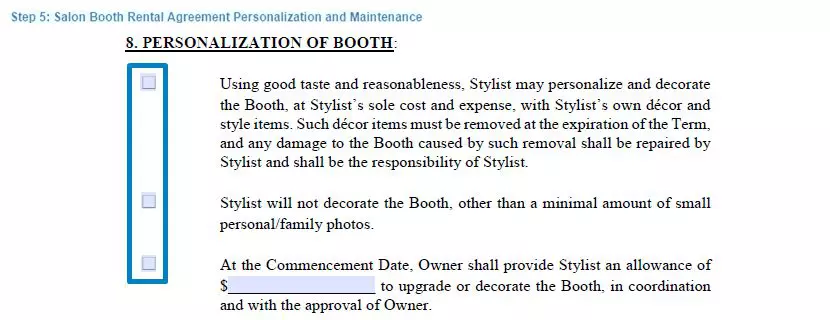
Personalization is often limited in booth rental, but it’s important to allow at least a little personalization and room for your stylists to store tools and products in and around their booth. This section will cover what is and is not allowed. Maintenance covers the cleaning and any additional maintenance required by the salon. It does not need to cover everything the stylist intends to do, only the bare minimum required by the owner.
Step 6: Insurance and Liability Information

The final section details the kind of insurance the stylist is required to carry, as well as what insurance they currently have. Usually, the amount of insurance is dictated by the salon, but the stylist is free to choose their own provider. Several additional agreements and liability clauses also must be included in the agreement, and which are not open for negotiation or modification by the salon owner or stylist. These clauses all come at the end, but it’s important to read them all to understand both parties’ responsibilities.
Step 7: Other Terms and Signatures

Once the rest of the contract is negotiated and finalized, it’s time to sign the agreement. Both the lessor and lessee need to sign and date. This document isn’t required to be notarized, but it will need to be kept filed and available as proof that the stylist is an independent contractor, not an employee. At a minimum, both signatory parties should have a copy.

With over 25 years of experience as a business and transactional attorney, Jennifer has mastered the craft of closing highly successful deals for her clients. Through her wide-ranging expertise in commercial contracts, real estate transactions, M&A and corporate law, Jennifer secures results that are second-to-none.